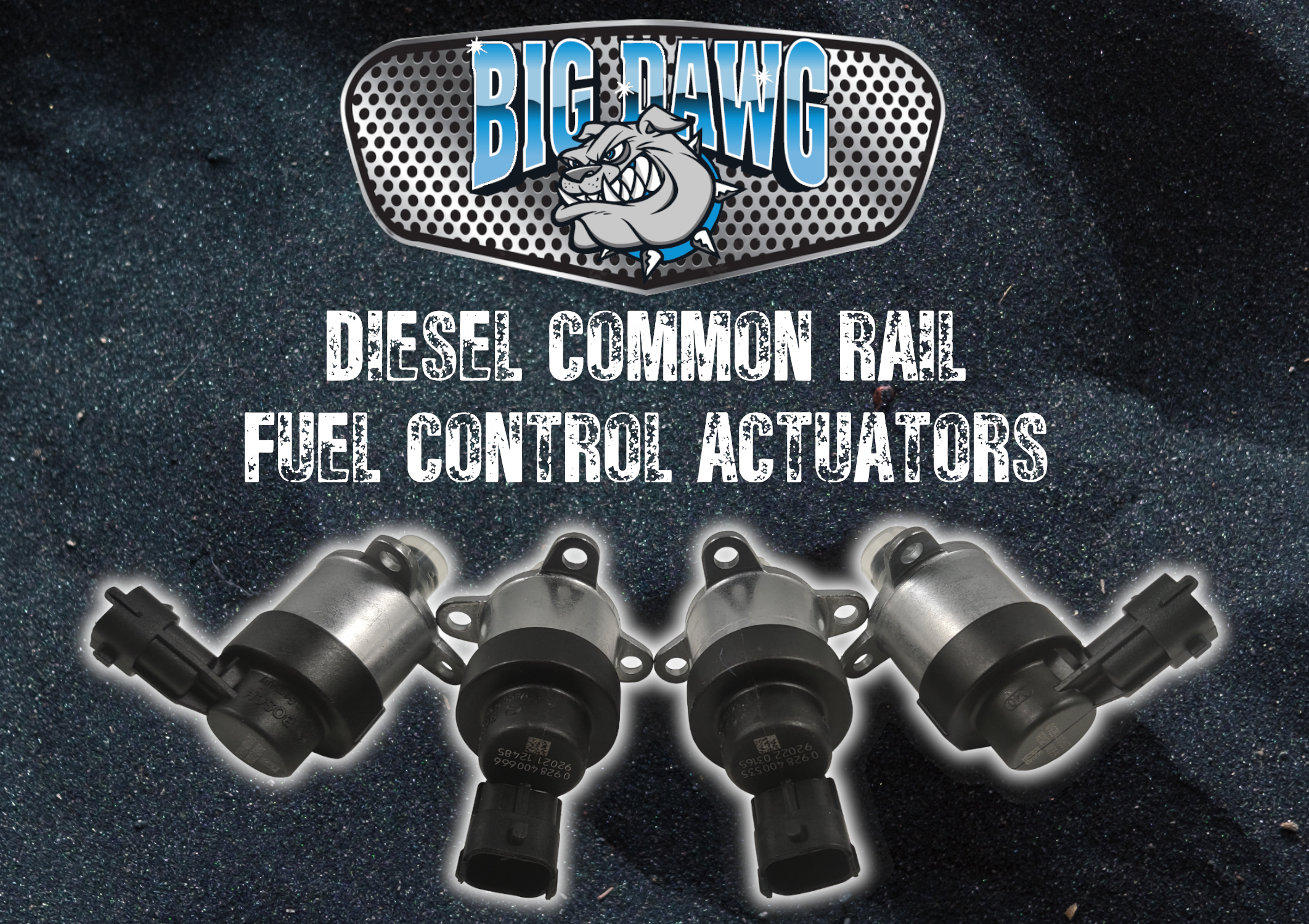Unveiling the Fuel Control Actuators in Diesel Fuel Pumps
Posted by Big Dawg Diesel on May 3rd 2024
In the intricate ecosystem of diesel engines, few components are as crucial as fuel control actuators, particularly in high-pressure fuel pumps like the CP3 and CP4. These small yet mighty devices play a pivotal role in regulating fuel delivery, ensuring optimal engine performance, efficiency, and emissions control. In this comprehensive exploration, we'll uncover the functions of fuel control actuators and shed light on the telltale signs of wear that indicate its need for attention.

Fuel Control Actuators: What is an FCA?
I’m sure at one point you will hear your diesel mechanic say the acronym FCA if they’re diagnosing your diesel truck because of fuel performance issue. You just stand there thinking “What the bejeezus is an FCA?” (Who says bejeezus these day?). At the heart of every diesel fuel pump lies a fuel control actuator, a sophisticated electromechanical device tasked with modulating fuel pressure and volume. In essence, fuel control actuators serve as the brains behind the brawn of the fuel pump, precisely regulating fuel delivery to meet the engine's demands across various operating conditions.
Fuel control actuators operate in conjunction with the engine's electronic control unit (ECU), receiving signals that dictate the desired fuel pressure and volume based on factors such as engine speed, load, and temperature. By adjusting the position of internal components within the fuel pump, such as the regulator valve or metering valve, fuel control actuators fine-tune fuel delivery to achieve optimal combustion efficiency and power output.
Functions of Fuel Control Actuators (FCA)
1. Fuel Pressure Regulation:
One of the primary functions of fuel control actuators is to regulate fuel pressure within the fuel pump. By adjusting the position of the regulator valve, actuators modulate the flow of fuel to maintain the desired pressure levels, ensuring consistent and reliable engine performance.
2. Fuel Volume Control:
In addition to pressure regulation, fuel control actuators also govern fuel volume delivery. By precisely controlling the position of the metering valve or piston, actuators dictate the amount of fuel injected into the combustion chamber during each cycle, optimizing combustion efficiency and emissions control.
3. Adaptability to Operating Conditions:
Fuel control actuators are designed to adapt to a wide range of operating conditions, from idling to full load. By continuously monitoring engine parameters and receiving input from the ECU, actuators dynamically adjust fuel delivery to meet changing demands, ensuring smooth and responsive engine operation across the entire rpm range.
Signs of Wear and Degradation
Despite their critical role in engine performance, fuel control actuators are not immune to wear and degradation over time. As these components are punished with high pressures, temperatures, and mechanical stresses, they may exhibit signs of wear that you may want to pay close attention to. Here are some common indicators of fuel control actuator wear:
1. Loss of Power or Efficiency:
A dip or decline in engine power or fuel efficiency can be a telltale sign of fuel control actuator malfunction. If the actuator fails to maintain optimal fuel pressure or volume, engine performance may suffer, resulting in reduced power output and increased fuel consumption.
2. Rough Idle or Misfires:
You're able to hear and feel this one. Fuel control actuators play a critical role in regulating fuel delivery during idle conditions. If the actuator fails to maintain consistent fuel pressure or volume, the engine may experience rough idling, misfires, or hesitation, indicating a potential issue with the fuel pump's functionality.
3. Check Engine Light (CEL) Illumination:
In modern diesel engines, the ECU continuously monitors various engine parameters and components for signs of malfunction. If the ECU detects an issue with the fuel control actuator or fuel pump, it may trigger the illumination of the check engine light (CEL) to alert the driver to a potential problem.
4. Fuel Pump Noise or Vibration:
Excessive noise or vibration emanating from the fuel pump area can be indicative of internal wear or damage to the fuel control actuator. As components wear down, they may generate increased friction or resistance within the fuel pump, resulting in audible or tactile abnormalities.
Addressing Fuel Control Actuator Issues
When faced with signs of fuel control actuator wear or degradation, prompt action is essential to prevent further damage to the engine and fuel system. Here are some steps to consider:
1. Diagnostic Assessment:
If you suspect a problem with the fuel control actuator or fuel pump, it's essential to conduct a comprehensive diagnostic assessment using specialized diagnostic equipment. This will help pinpoint the root cause of the issue and determine the appropriate course of action.
2. Replacement or Repair:
Depending on the extent of wear or damage, fuel control actuators may need to be replaced or repaired to restore proper functionality. In some cases, minor repairs or adjustments may suffice, while severe damage may necessitate the installation of a new actuator assembly.
3. Quality Replacement Parts:
When replacing fuel control actuators or fuel pump components, it's crucial to use high-quality replacement parts from reputable manufacturers. OEM (original equipment manufacturer) parts or aftermarket equivalents that meet or exceed OEM specifications are recommended to ensure compatibility, reliability, and durability.
4. Professional Service:
For complex diagnostic procedures or component replacements, it's advisable to seek the expertise of trained professionals or certified technicians. Diesel engines and fuel systems are highly specialized, and improper handling or installation can lead to further complications or damage.
Codes, Codes, and More Codes
Several trouble codes can indicate a worn-out fuel control actuator, signaling potential issues with fuel delivery and engine performance. These codes are typically detected by the engine control module (ECM) during diagnostic scans. Here are several common trouble codes associated with a faulty fuel control actuator:
P0251 - Injection Pump Fuel Metering Control "A" Malfunction:
This code indicates a problem with the fuel metering control circuit, often caused by a faulty fuel control actuator. It suggests that the ECM has detected an abnormal signal or voltage from the actuator, affecting fuel delivery.
P0252 - Injection Pump Fuel Metering Control "A" Range/Performance:
Similar to P0251, this code points to issues with fuel metering control but specifically relates to performance or range abnormalities. It indicates that the ECM has detected a deviation from expected fuel delivery parameters, potentially due to a worn or malfunctioning actuator.
P0253 - Injection Pump Fuel Metering Control "A" Low:
This code signifies that the ECM has detected a low voltage signal from the fuel control actuator, indicating insufficient fuel delivery. A worn-out actuator may struggle to maintain proper fuel pressure or volume, triggering this code.
P0254 - Injection Pump Fuel Metering Control "A" High:
Conversely, P0254 indicates a high voltage signal from the fuel control actuator, suggesting excessive fuel delivery. This code may occur if the actuator fails to regulate fuel pressure effectively, leading to an overabundance of fuel in the combustion chamber.
P1093 - Fuel Rail Pressure Low During Power Enrichment:
This code relates to low fuel rail pressure during periods of increased engine demand, such as acceleration or heavy load conditions. A worn or malfunctioning fuel control actuator may struggle to maintain adequate fuel pressure, resulting in fuel delivery issues and triggering this code.
P1094 - Fuel Rail Pressure Low During Power Replenishment:
Similar to P1093, this code indicates low fuel rail pressure but specifically during fuel replenishment cycles. It suggests that the fuel system is unable to maintain sufficient pressure to meet engine demands, potentially due to a worn-out fuel control actuator.
P0087 - Fuel Rail/System Pressure Too Low:
This code indicates that the fuel rail or system pressure is below the expected threshold, which may be caused by various factors, including a faulty fuel control actuator. Insufficient fuel pressure can lead to engine hesitation, rough idling, and reduced performance.
These trouble codes serve as valuable diagnostic tools for identifying potential issues with the fuel control actuator and fuel delivery system. If any of these codes are detected during a diagnostic scan, it's essential to conduct further inspection and testing to pinpoint the root cause of the problem and take appropriate corrective action. Ignoring these codes or failing to address underlying issues promptly can lead to further engine damage and performance degradation.
The Wrap-up
Fuel control actuators are integral components of diesel fuel pumps, playing a critical role in regulating fuel pressure and volume for optimal engine performance. By understanding their functions and recognizing the signs of wear and degradation, diesel engine owners and mechanics can proactively address issues and ensure the continued reliability and efficiency of their engines. With proper maintenance, quality replacement parts, and professional service, fuel control actuators can help diesel engines deliver the power, efficiency, and durability they're renowned for.
